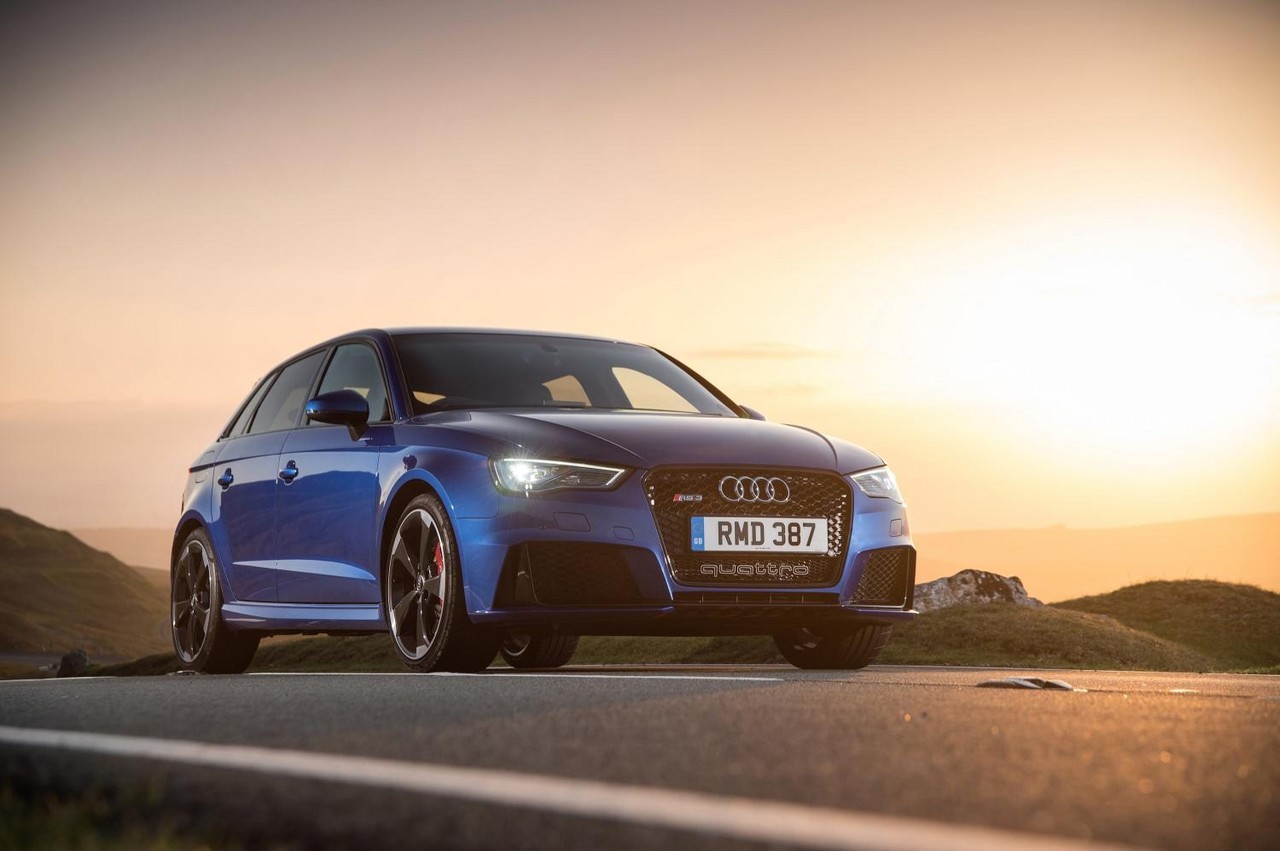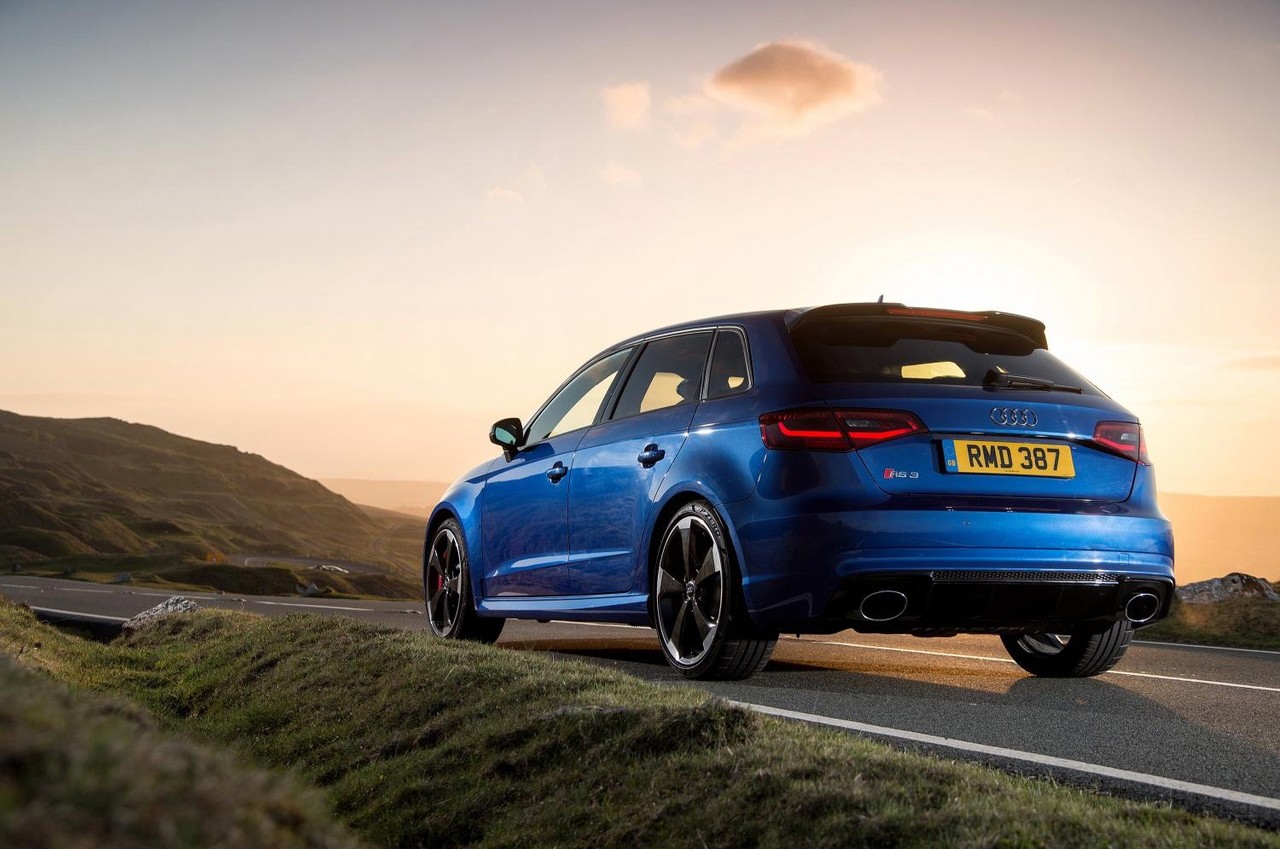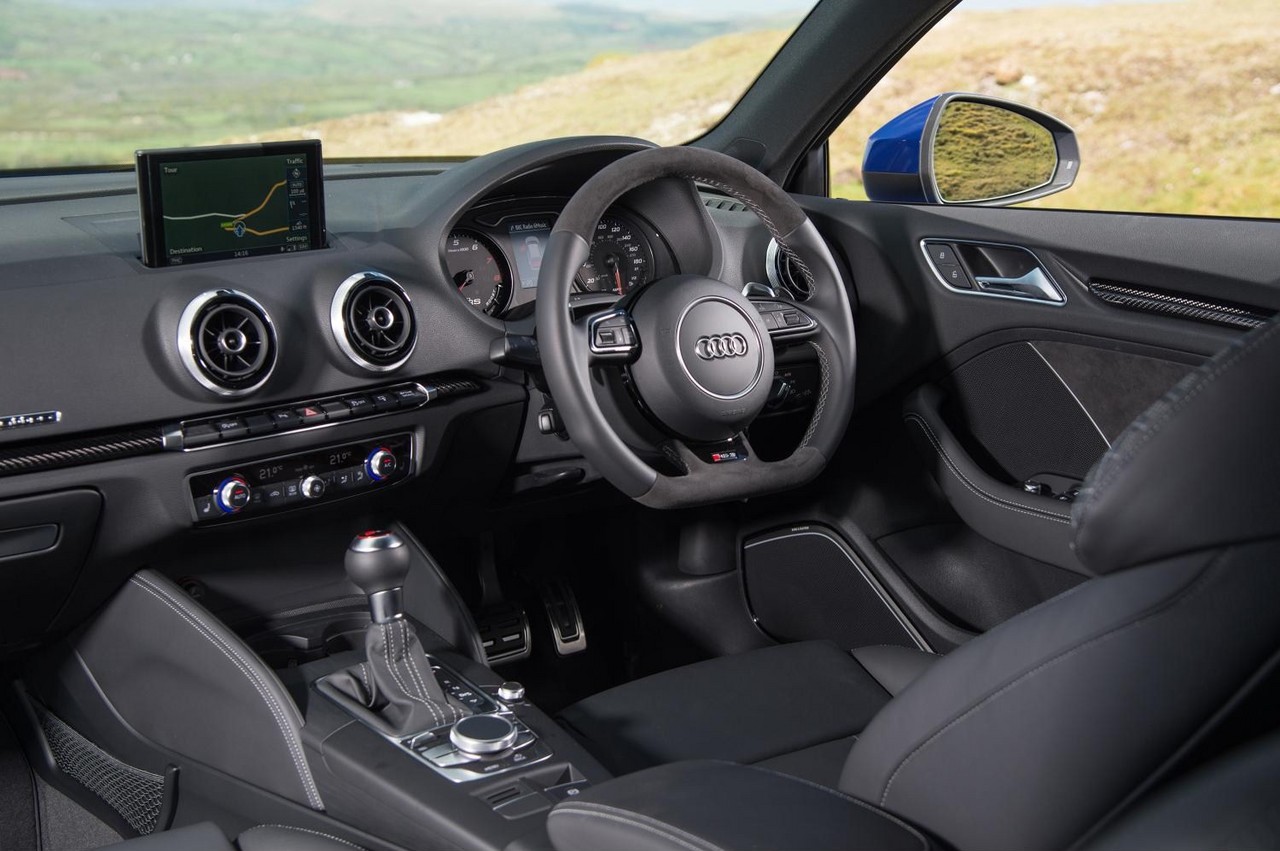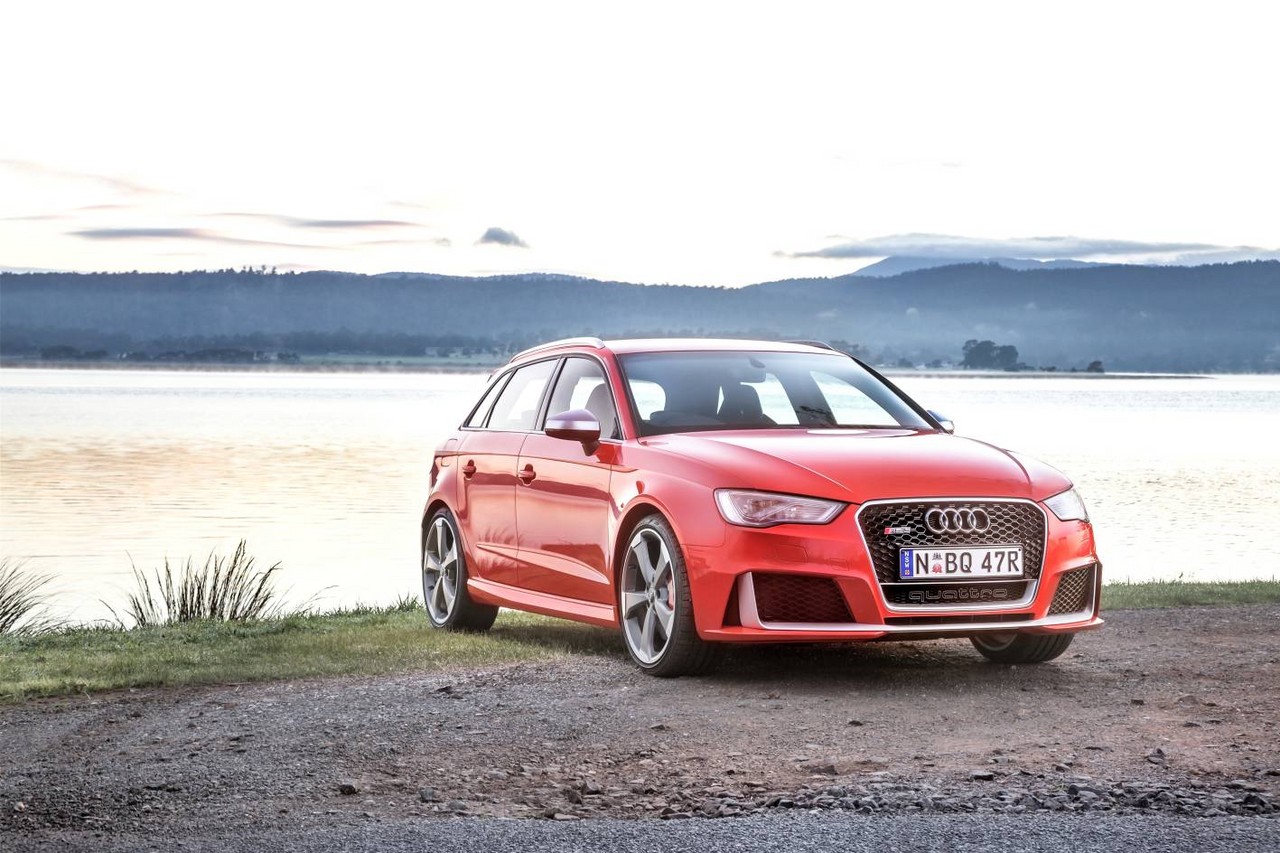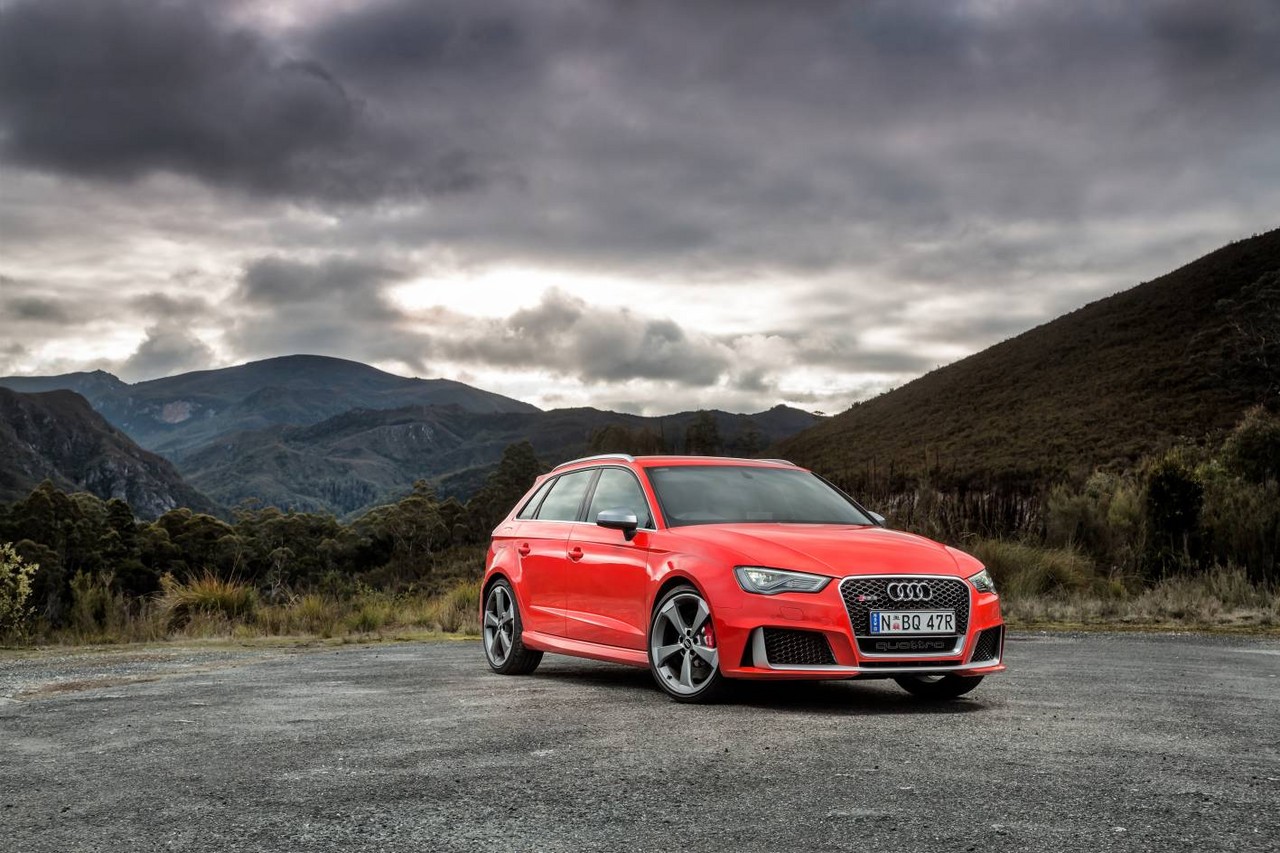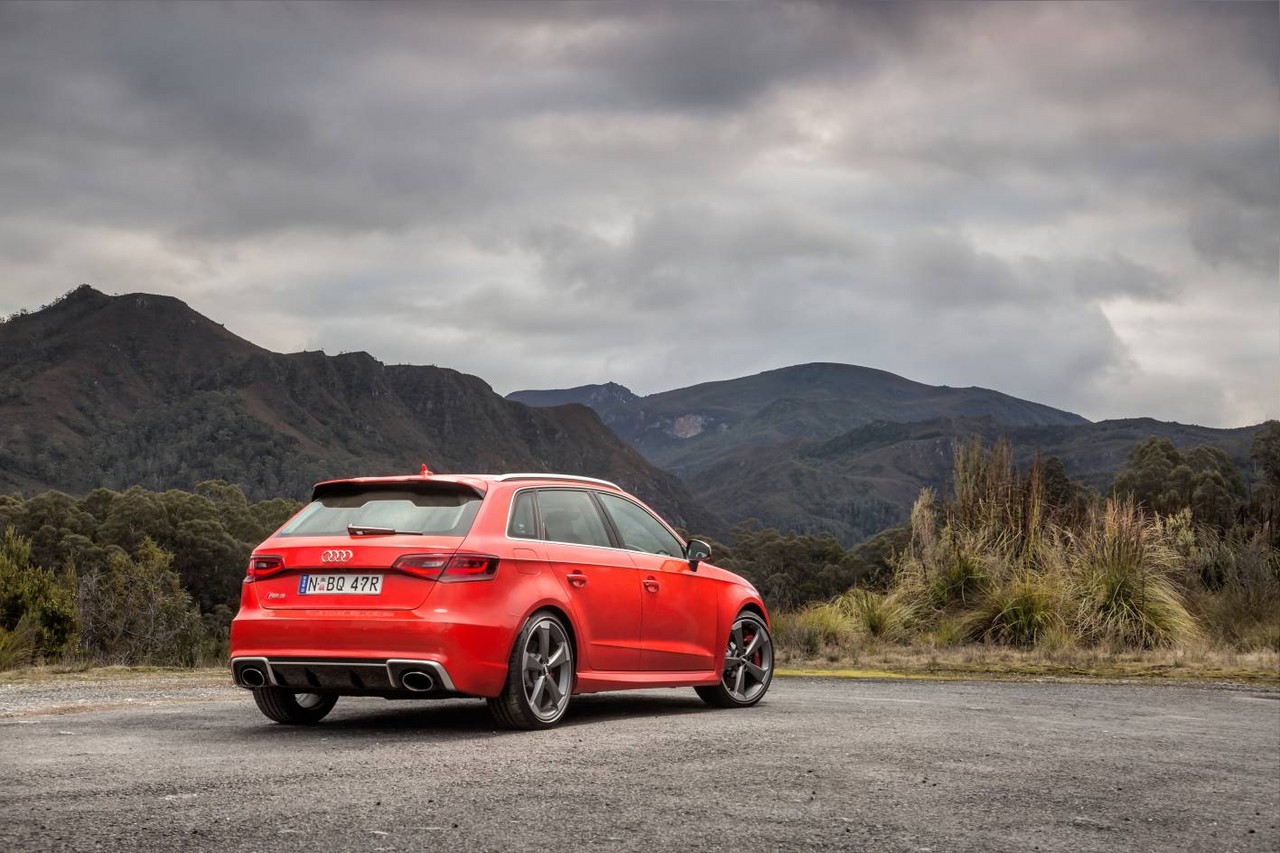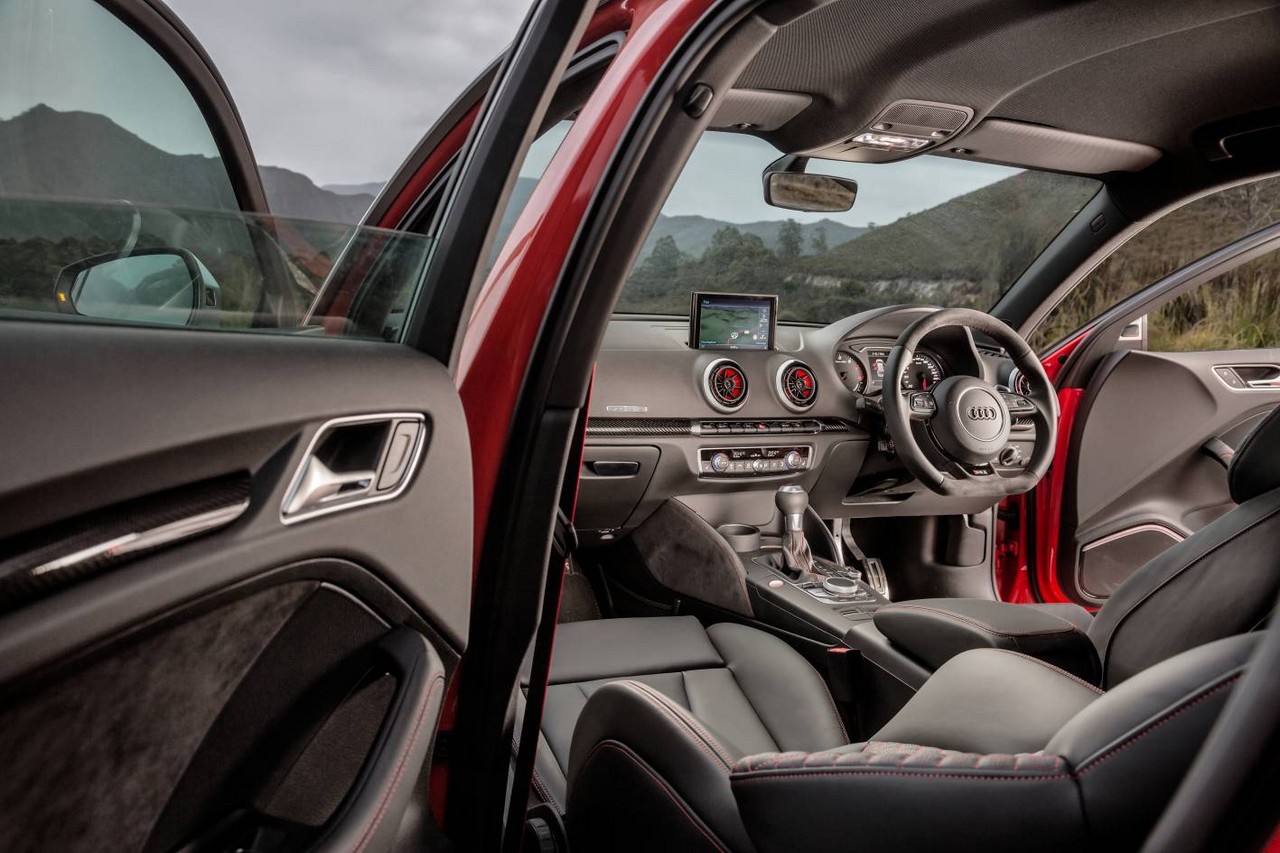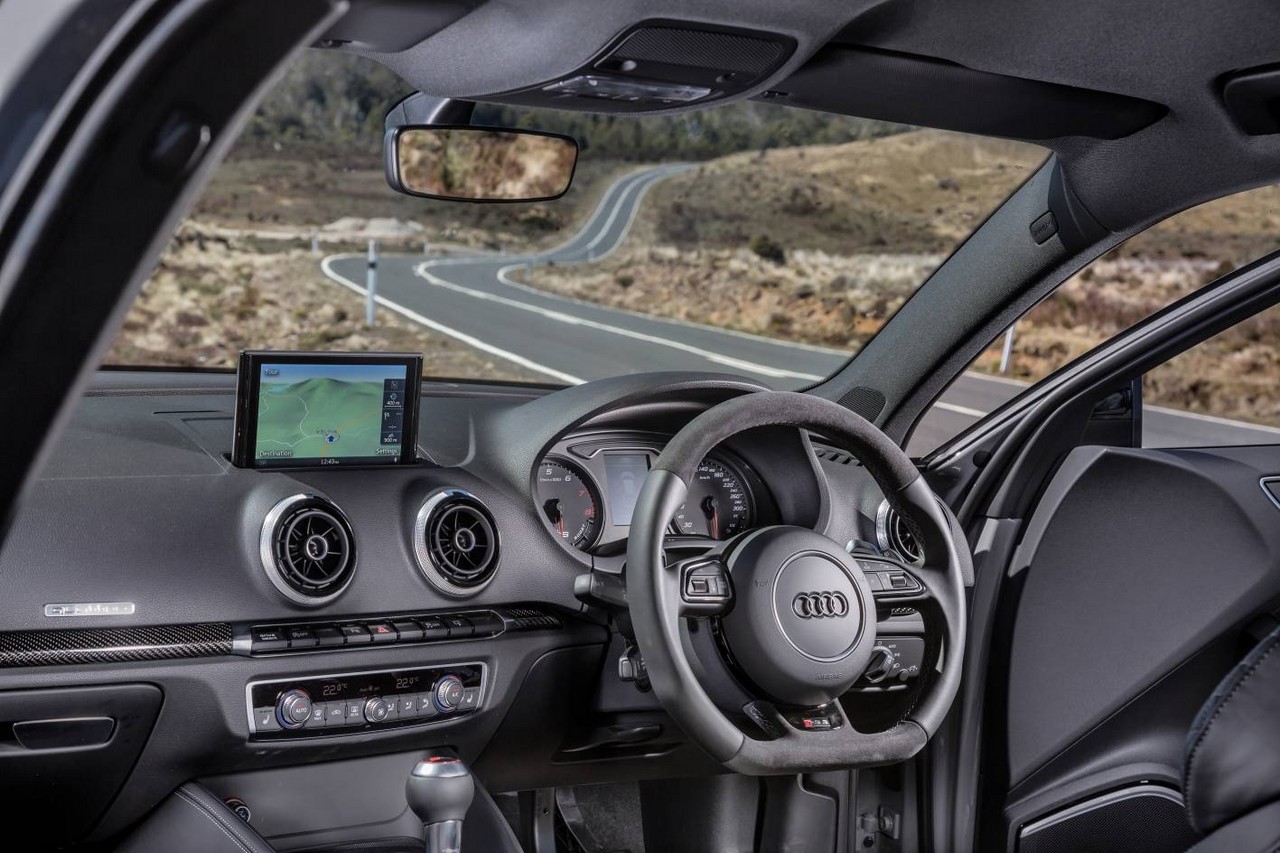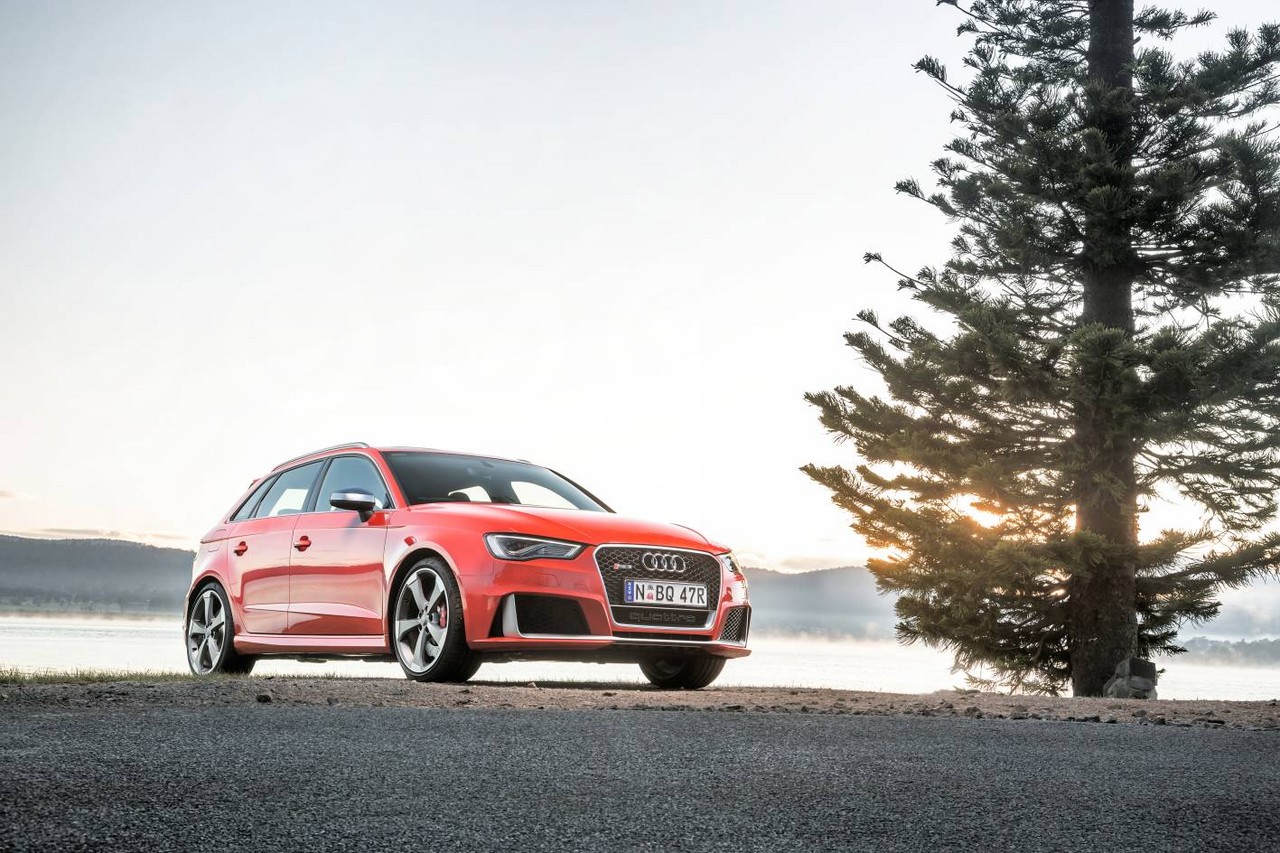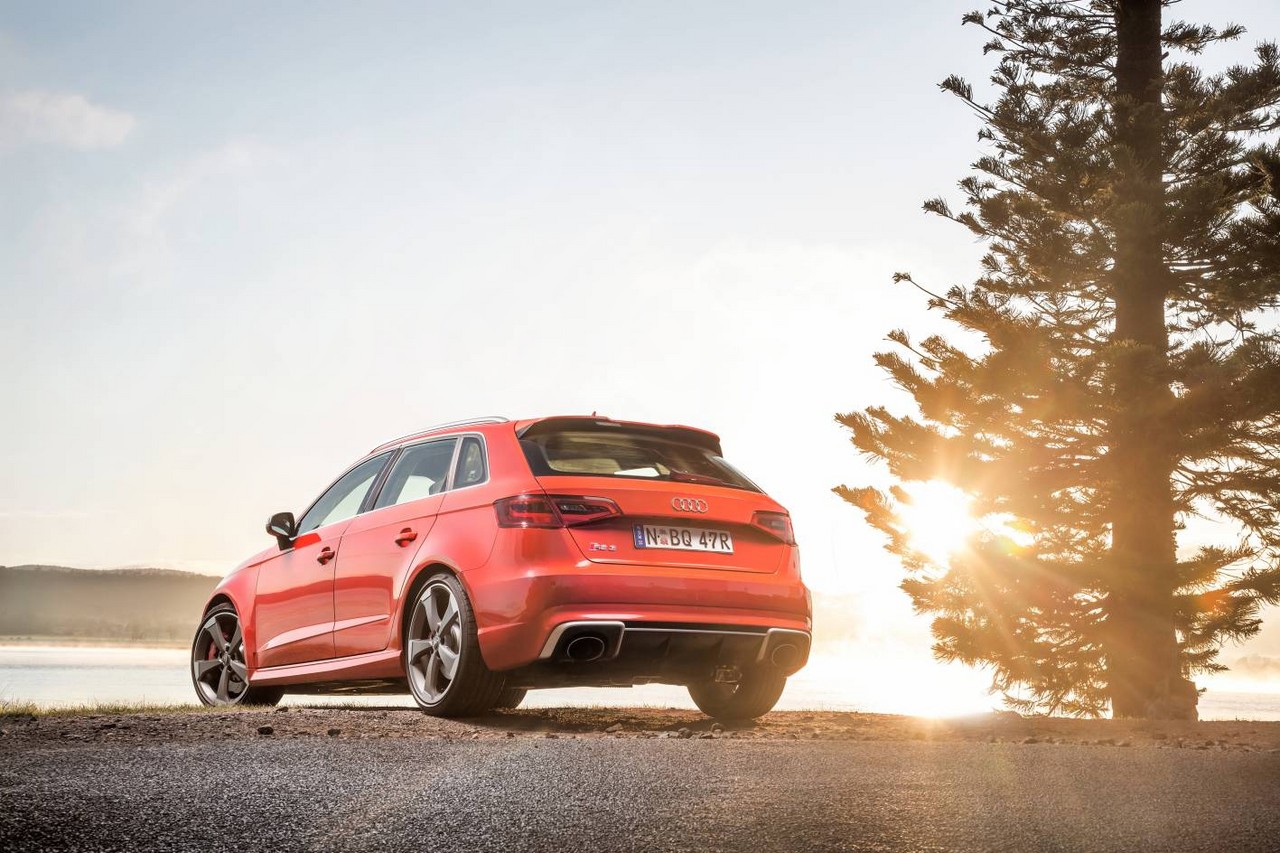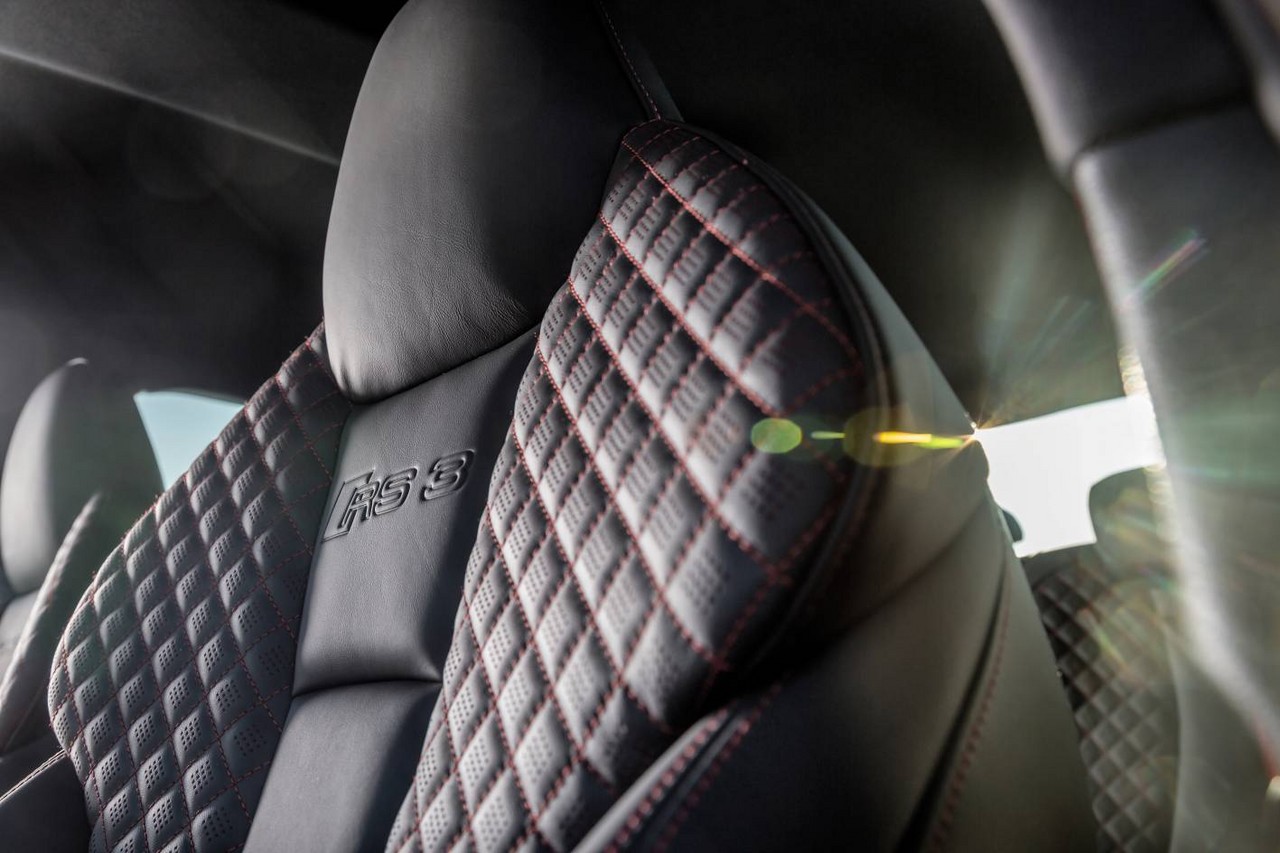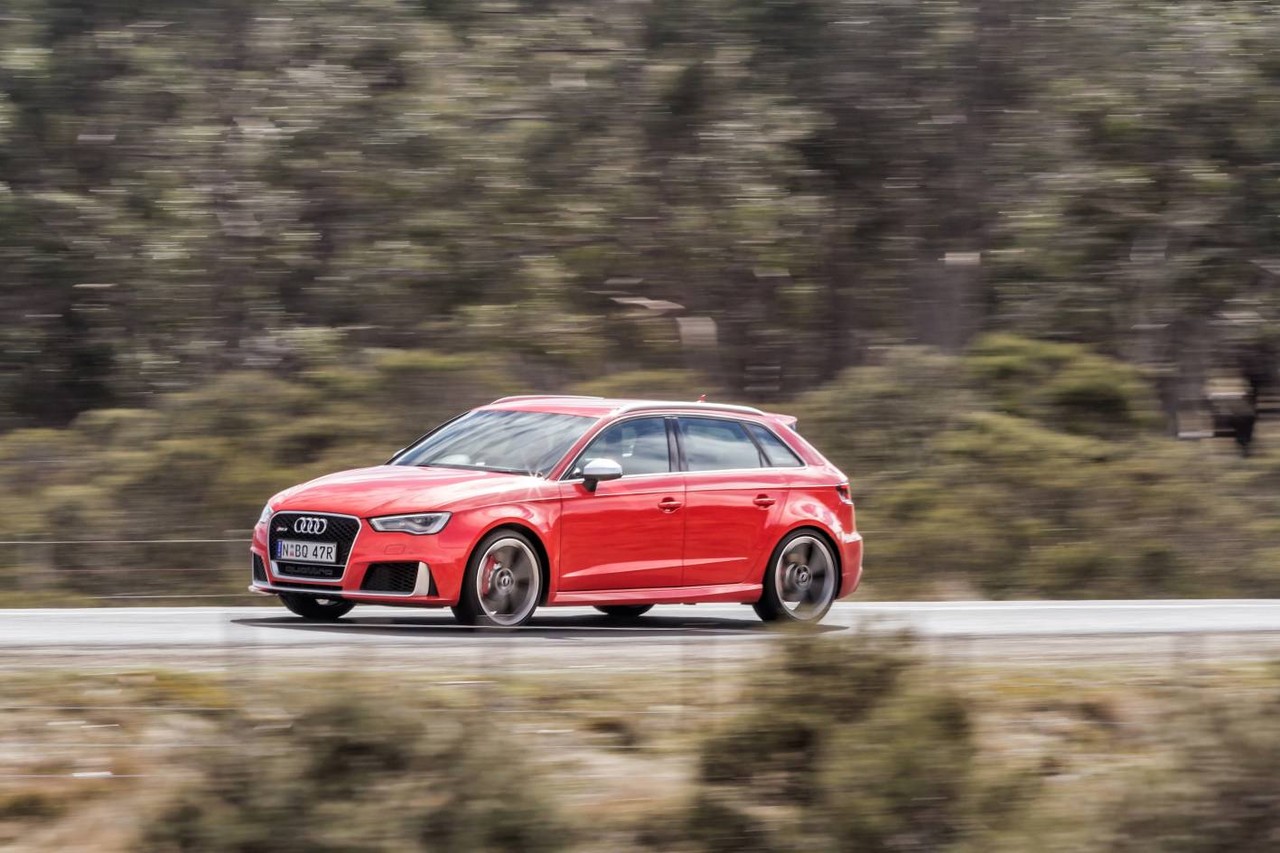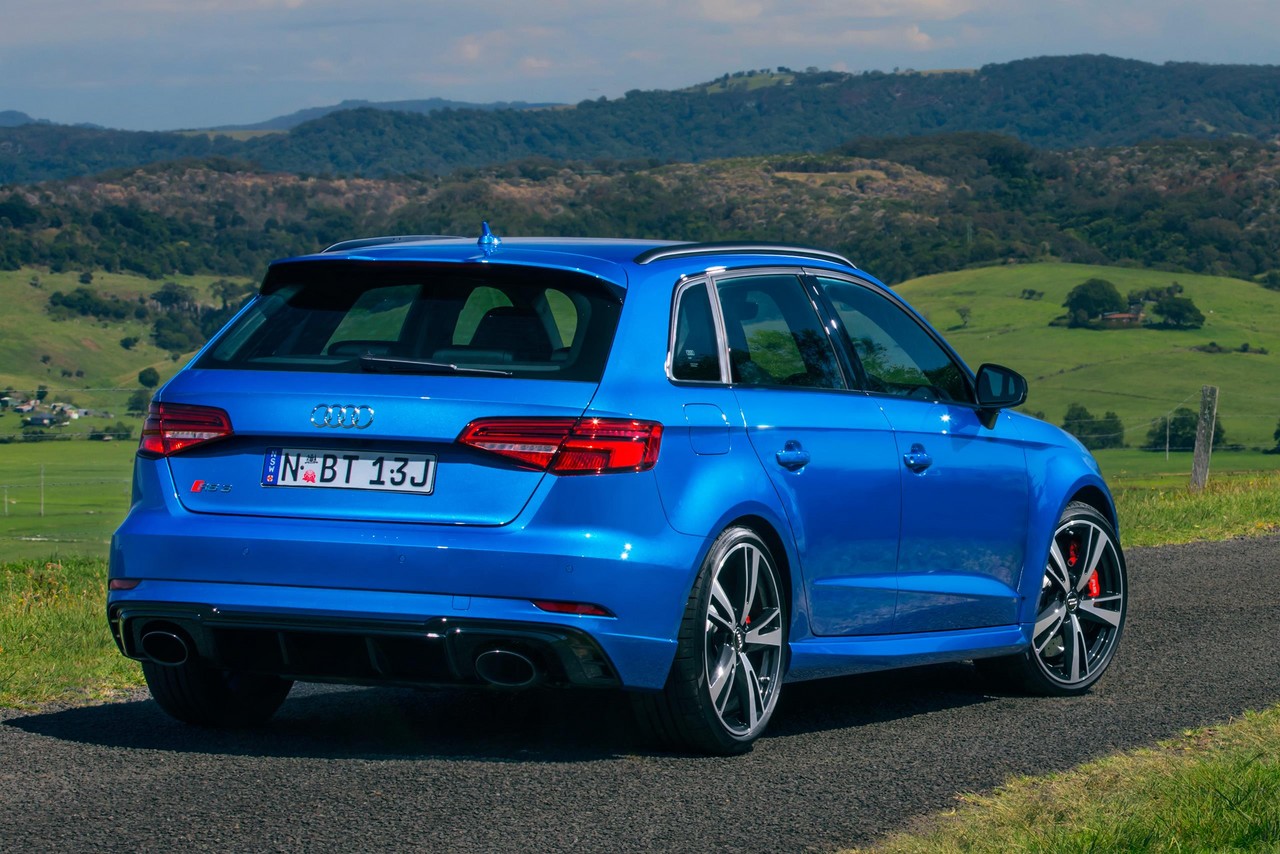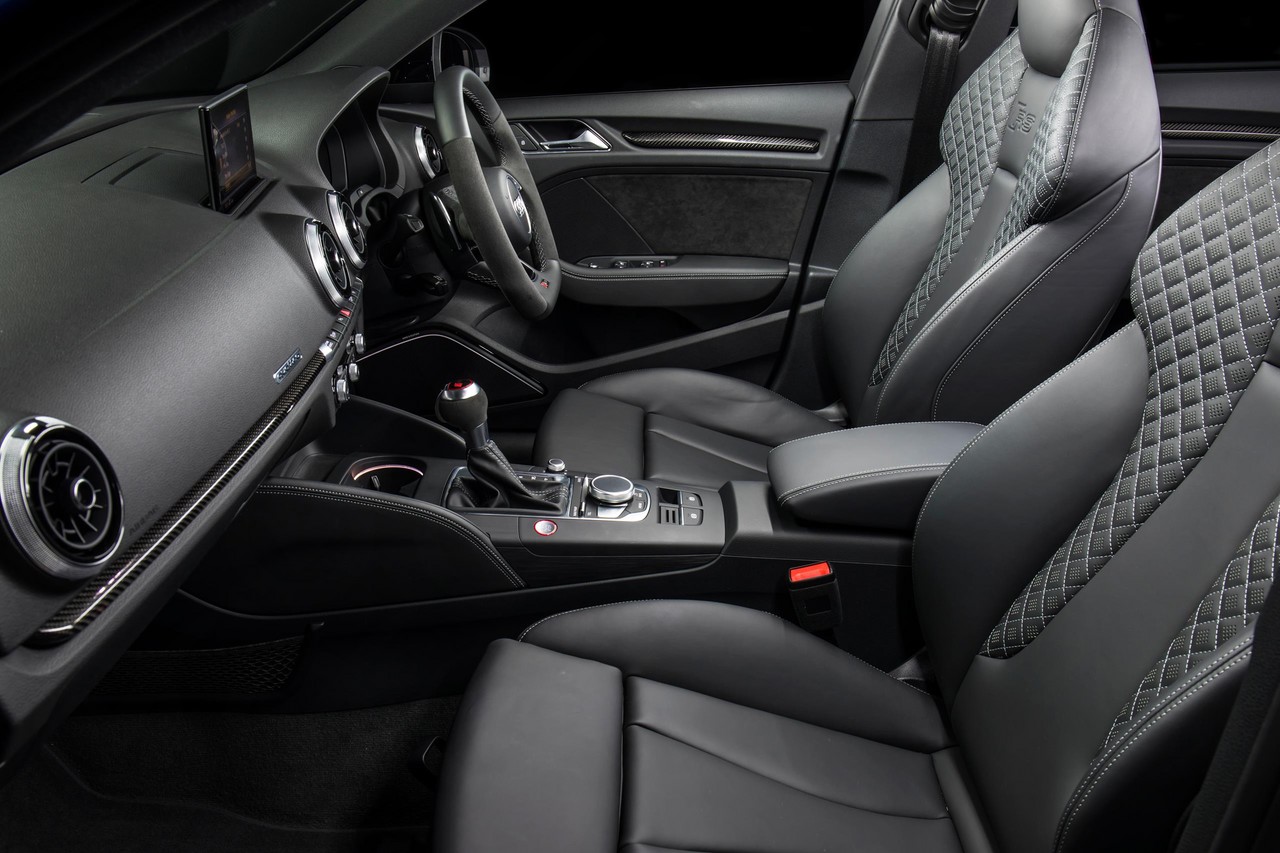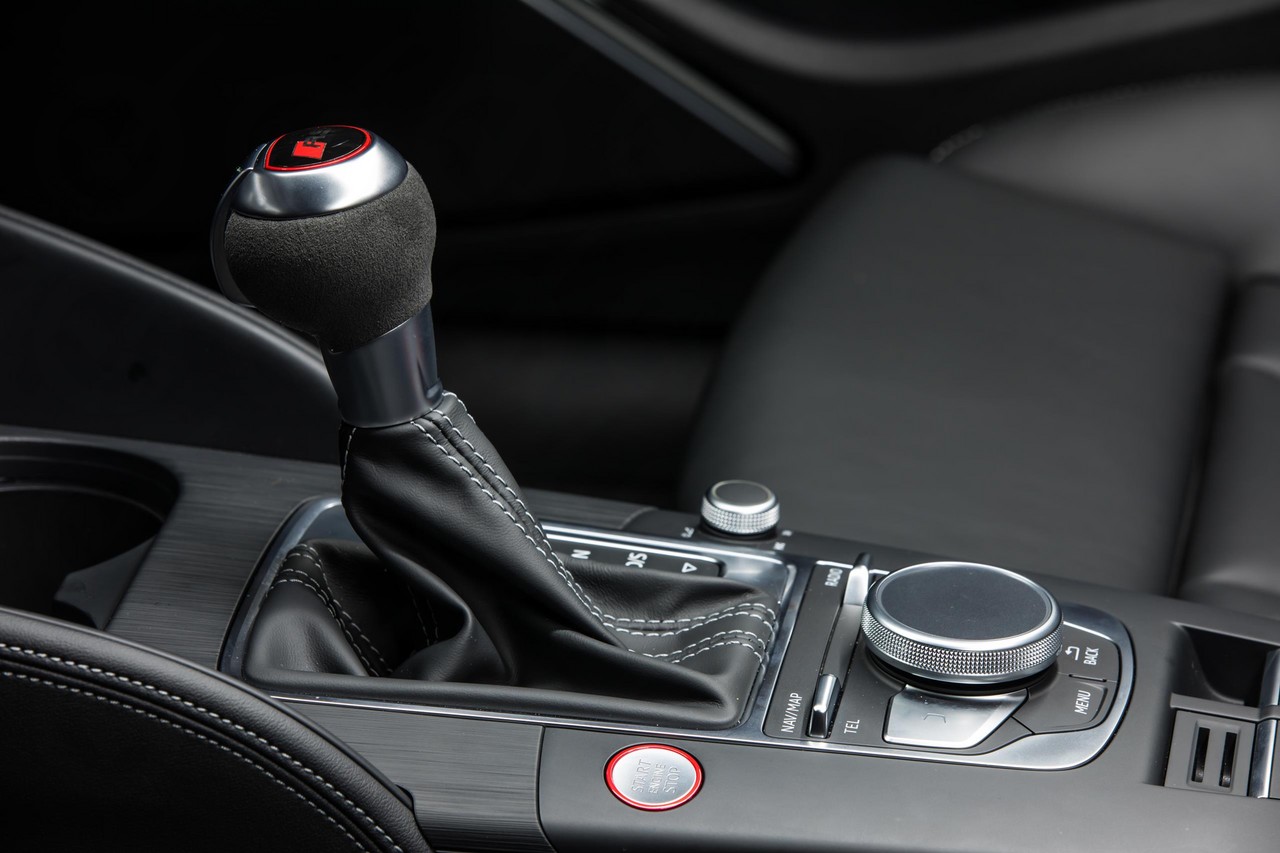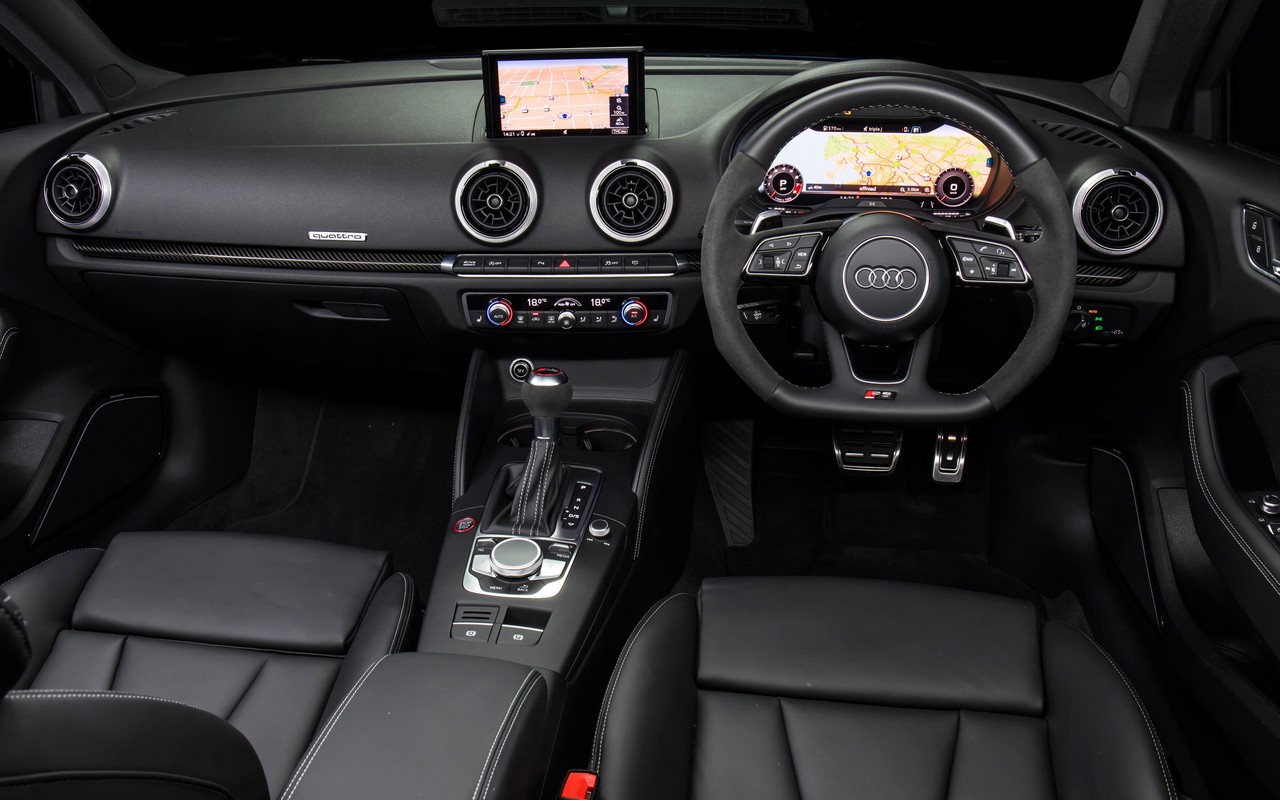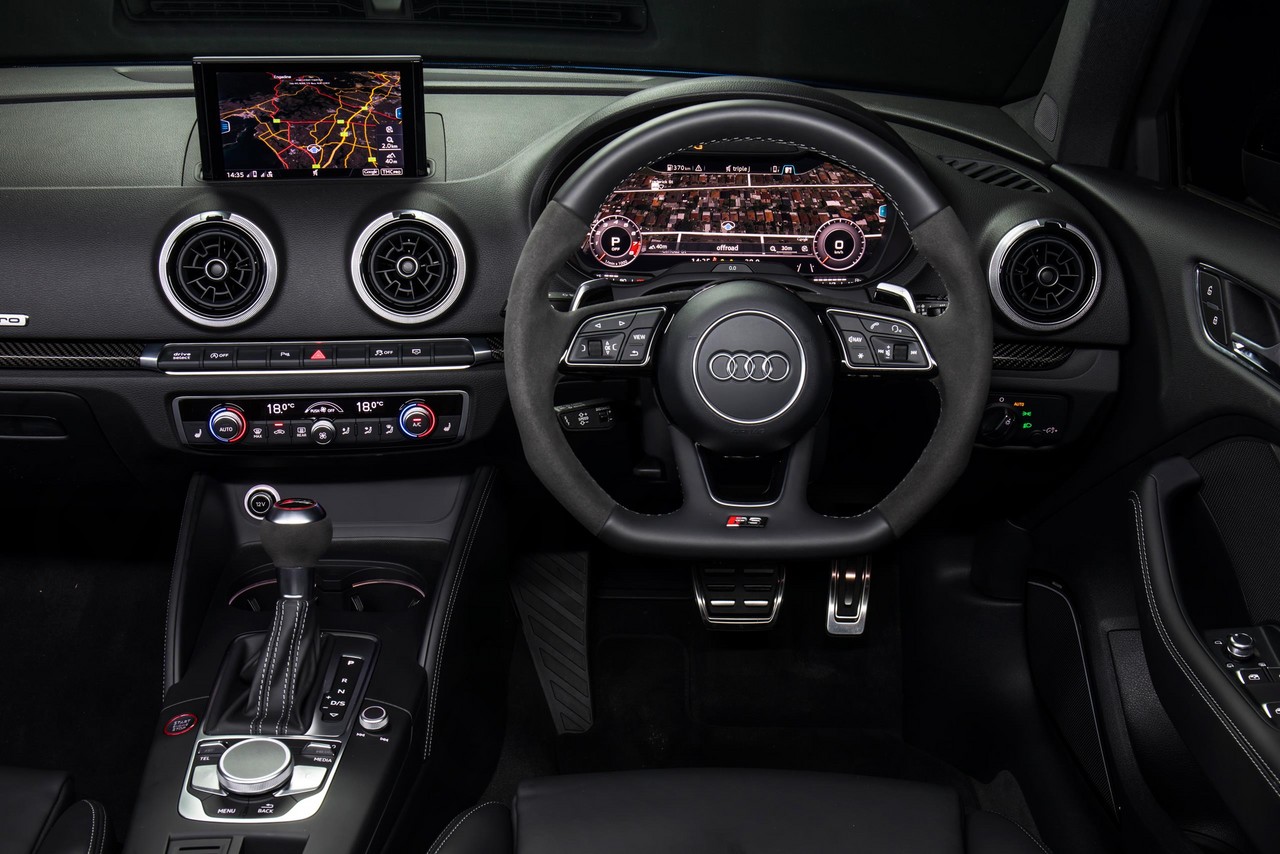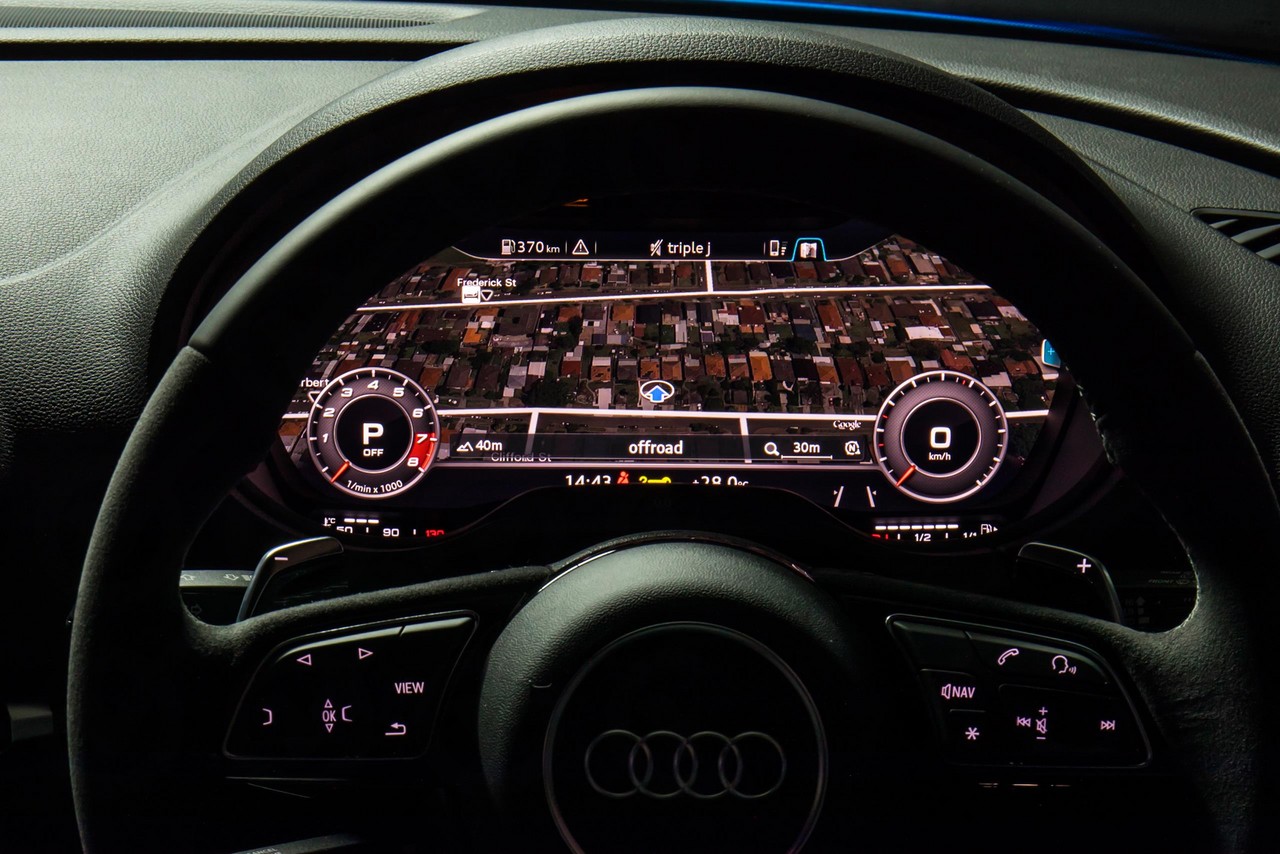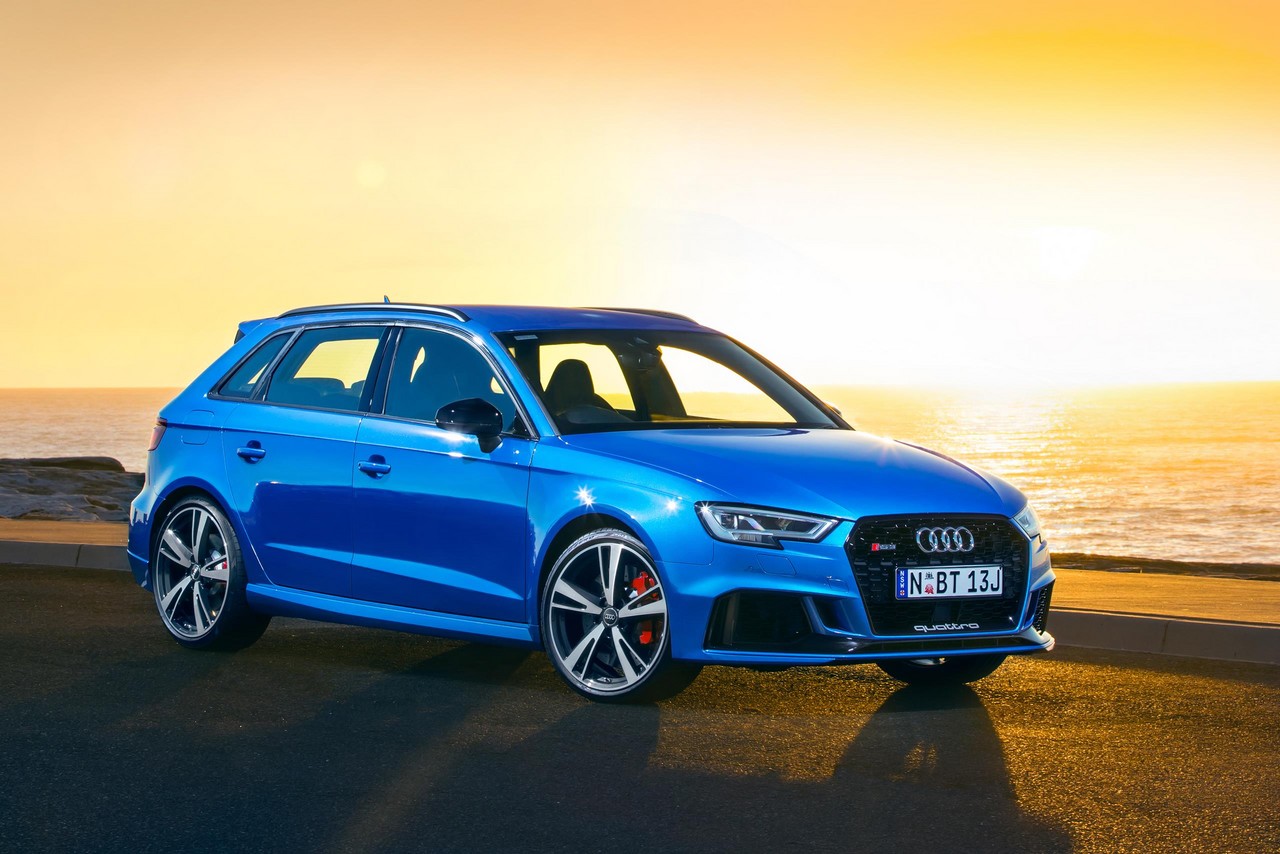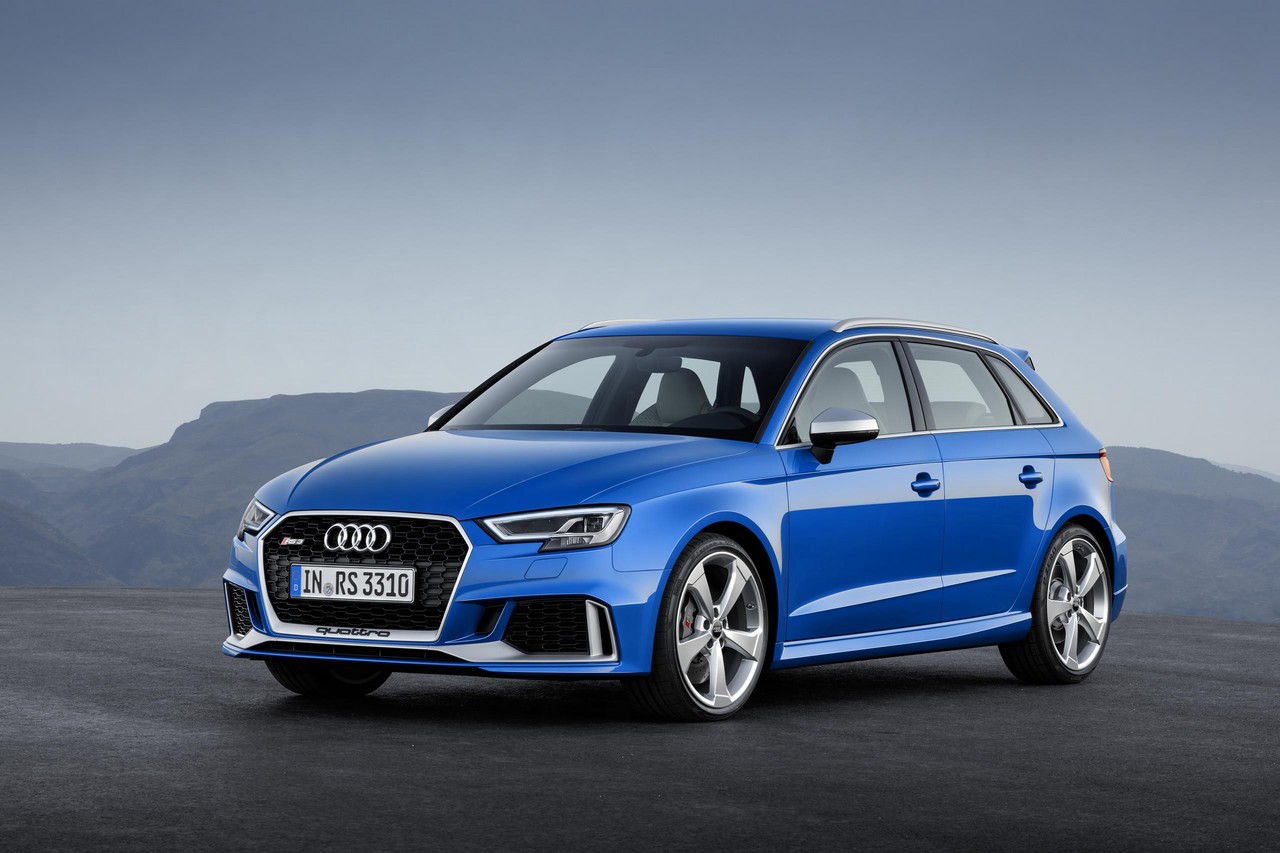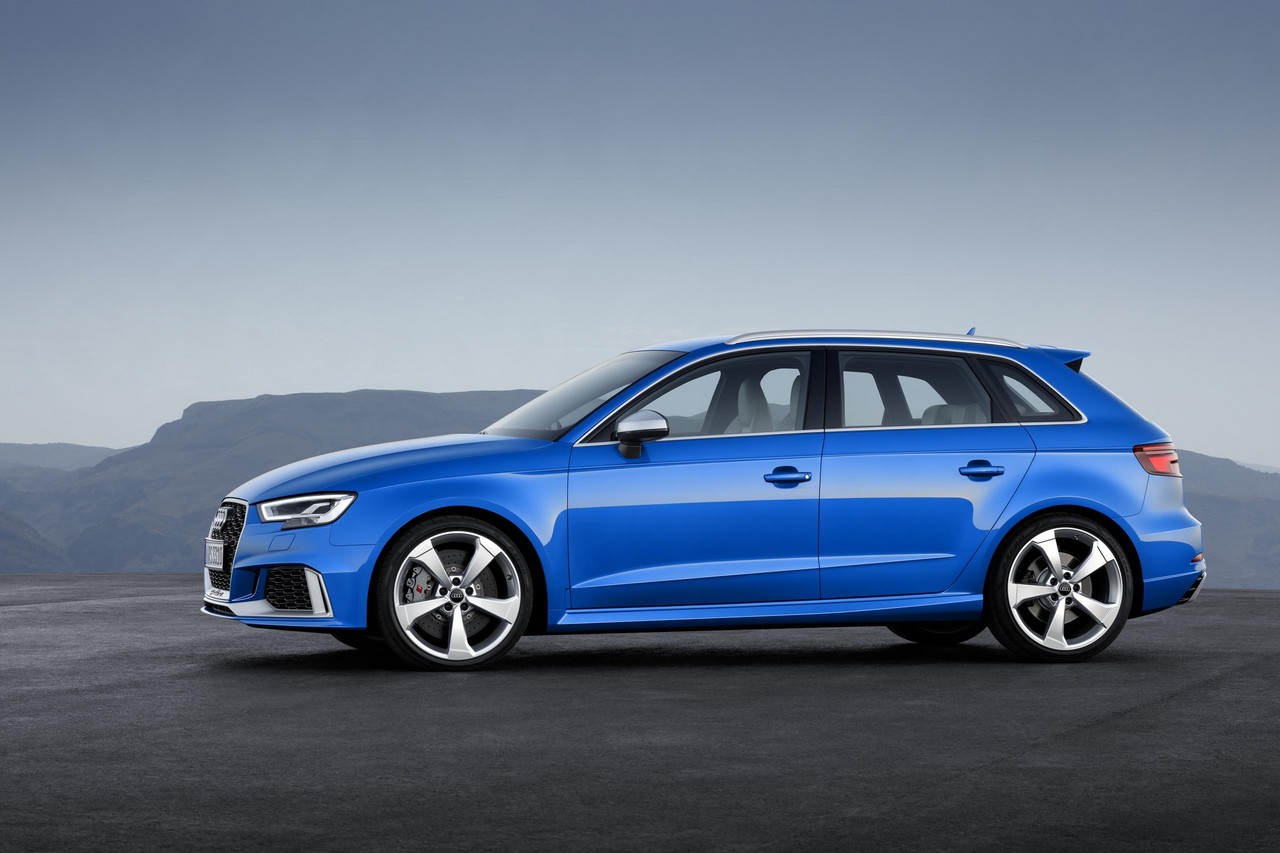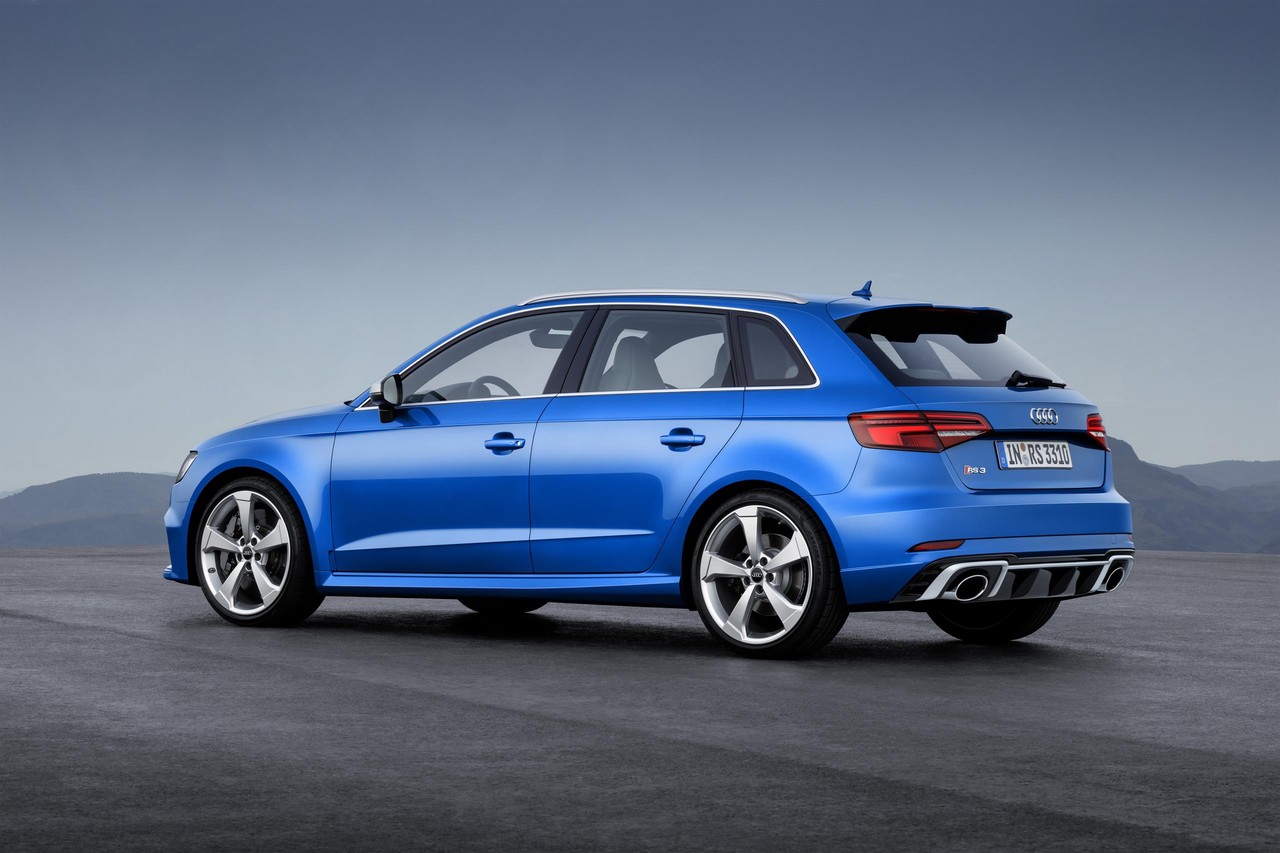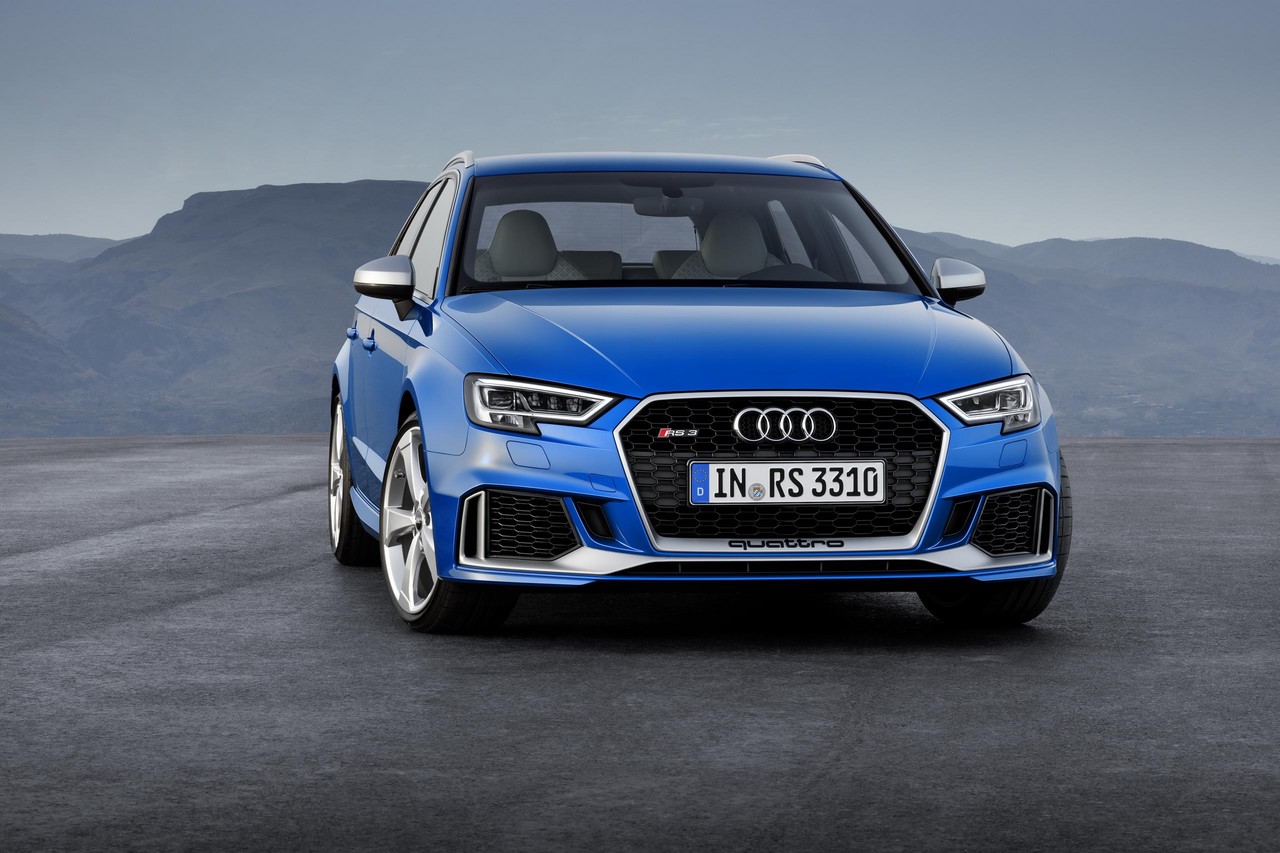
- Characterful and powerful 2.5-litre five-cylinder engine
- quattro system contributes to excellent dynamics
- S-Tronic transmission provides fast gearshifts
- Stiff suspension
- Tyre roar on coarse surfaces
- Gap in gear ratios from third to fourth
Review: Audi 8VA.I RS 3 Sportback (2015-17)
Overview
Released in Australia in October 2015, the Audi 8VA RS 3 Sportback was a five-door hatchback. Manufactured in Ingolstadt, Germany, the all-wheel drive Audi RS 3 Sportback was powered by a 2.5-litre turbocharged five-cylinder petrol engine that was mated to a seven-speed dual clutch transmission (DCT).
2.5 R5 TFSI: CZGB engine
The Audi RS 3 Sportback’s CZGB engine was based on the CEPA engine which powered the Audi 8J TT RS Coupe . Hand-built in Gyor, Hungary, the CZGB engine had a graphite cast iron block, a die-forged steel crankshaft supported by six main bearings, forged connecting rods, cast aluminium alloy pistons, a cast aluminium-silicon alloy cylinder head, chain-driven double overhead camshafts, variable intake and exhaust camshaft timing, four valves per cylinder actuated by roller finger followers and a compression ratio of 10.0:1. Furthermore, the CZGB engine was fitted with BorgWarner K16 turbocharger which provided peak boost pressure of 1.35 bar (19.6 psi).
To minimise fuel consumption, the CZGB engine had a ‘Start-Stop’ system which enabled it to shut down when the RS 3 Sportback was stationary in traffic. The RS 3 Sportback is capable of accelerating from rest to 100 km/h in 4.3 seconds and has an electronically-limited top speed of 255 km/h.
| Engine | Trans. | Peak power | Peak torque |
|---|---|---|---|
| 2.5-litre CZGB turbo petrol I5 | 7sp DCT | 270 kW at 5550-6800 rpm | 465 Nm at 1625-5500 rpm |
quattro AWD system
The Audi 8VA RS 3 Sportback had a fifth-generation Haldex all-wheel drive system which consisted of an electronically controlled and hydraulically actuated multi-plate clutch that was located in front of the rear axle differential (at the end of the prop shaft). Under low loads or when coasting, the rear axle was decoupled to minimise fuel consumption. If there was a loss of traction, or such a loss was anticipated by on-board sensors, the clutch would engage to transfer torque to the rear axle ‘in just a few milliseconds’ by forcing the plates within the clutch together.
Dimensions
The Audi 8VA RS 3 Sportback was 4343 mm long, 1800 mm wide, 1411 mm tall and has a 2631 mm long wheelbase; excluding the driver, kerb weight was 1520 kg.
Suspension and steering
The Audi RS 3 had MacPherson strut front suspension with lower wishbones and four-link rear suspension (with sword-shaped trailing links for propulsion and braking forces and three wishbones per wheel for lateral forces). As an extra-cost option, the RS 3 was available with magnetorheological fluid-filled dampers (‘Audi magnetic ride’) which could vary their resistance through the application of an electric current that increased the viscosity of the fluid.
The Audi 8VA RS 3 had electromechanical power-assisted steering with variable steering ratios that ranged from 10.9:1 to 15.3:1.
Safety equipment
Standard safety equipment for the Audi RS 3 Sportback included dual front airbags, a driver’s knee airbag, front side airbags, full-length curtain airbags (i.e. for front and rear occupants), ABS, electronic brake force distribution, brake assist, electronic stability control, traction control and front seatbelts with pretensioners and load limiters.
The RS 3 Sportback was fitted with Audi’s ‘side assist’ blind spot monitoring system which uses a rear-facing radar to monitor traffic that is approaching from behind.
Brakes
The Audi RS 3 had 370 mm (diameter) by 34 mm ventilated front brake discs with eight-piston fixed calipers and 310 mm by 22 mm ventilated rear discs. In international markets, the Audi RS 3 was available with carbon fibre-ceramic front brake discs.
Features: RS 3 Sportback
Standard features for the Audi RS 3 Sportback included 19-inch five-arm alloy wheels, digital radio (DAB+), Bluetooth mobile phone connectivity and audio streaming, Audi’s MMI navigation system with MMI touch, ‘Audi connect’ internet-based services, dual-zone climate control air conditioning, RS bucket seats upholstered in Fine Nappa leather with contrasting ‘rock grey’ stitching, LED headlights with LED daytime running lights, a flat-bottomed RS multifunction steering wheel with leather and Alcantara trim, Alcantara door inserts, stainless steel pedals, black faced instrument dials with red needles and white scales, a trip computer, an alarm and immobiliser.
As standard, the RS 3 Sportback was fitted with Audi’s ‘parking system plus’ which includes ultrasonic sensors (front and rear) and automated steering for both perpendicular and parallel parking manoeuvres.
Specifications
- Specifications: Audi 8VA RS 3 Sportback (October 2015)
- Technical Data: Audi 8VA RS 3 Sportback (October 2015)
Related links
Review: Audi 8VA.II RS 3 Sportback (2017-20)
Overview
Released in Australia in November 2017, the Audi 8VA Series II (8VA.II) RS 3 Sportback was powered by a new 2.5 TFSI engine (shared with the post-2017 Audi 8VS RS 3 Sedan ) and had a lighter seven-speed ‘S tronic’ double clutch transmission. Visually, the Audi 8VA.II RS 3 Sportback could be identified by the redesigned blade in its front bumper (intended to provide a wider appearance) and larger front air intakes).
2.5 DAZA engine
The 8VA.II RS 3 Sportback was powered by Audi’s DAZA 2480 cc five-cylinder petrol engine which had an aluminium alloy crankcase, a die-forged steel crankshaft supported by six main bearings, forged connecting rods, cast aluminium alloy pistons, a cast aluminium-silicon alloy cylinder head with an integrated turbocharger that provided peak boost pressure of 1.35 bar (19.6 psi), chain-driven double overhead camshafts, four valves per cylinder actuated by roller finger followers, variable intake and exhaust camshaft timing, variable exhaust valve lift (the ‘Audi valvelift system’ or AVS), and a dual injection system (i.e. port injection and direct injection).
Whereas the Audi 8VA.I RS 3 Sportback was powered by Audi’s CZGB engine which had a compacted graphite iron (CGI) cylinder block, the 2.5 TFSI DAZA engine for the post-2017 Audi 8VS RS 3 Sedan and Sportback had an alloy crankcase that was 26 kg lighter.
The Audi 8VA.II RS 3 Sportback could accelerate from rest to 100 km/h in 4.1 seconds (compared to 4.3 seconds for the 8VA.I RS 3 Sportback). Over the combined ADR 81/02 test cycle, fuel consumption for the Audi 8VA.II RS 3 Sportback was 8.4 litres per 100 km.
| Engine | Trans. | Peak power | Peak torque |
|---|---|---|---|
| 2480 cc DAZA turbo petrol I5 | 7sp DCT | 294 kW at 5850-7000 rpm | 480 Nm at 1700-5850 rpm |
Safety equipment
For the Audi 8VA.II RS 3 Sportback, the following active safety technologies were fitted as standard –
- Audi pre-sense front: scanned the road for vehicles when travelling at speeds up to 200 km/h and for pedestrians when travelling at speeds of up to 65 km/h. If there was a risk of collision, the driver would be warned and partial braking would be initiated automatically. If the collision risk persisted, full braking could be initiated (i.e. autonomous emergency braking or AEB);
- Adaptive Cruise Control (ACC): using two front radar sensors and the camera, ACC could maintain a specified distance – from five distances – between the A3 Cabriolet and the vehicle ahead. Furthermore, ‘Audi drive select’ could be used to adjust the rate of acceleration and other control dynamics;
- Stop&Go function: an extension of Adaptive Cruise Control, ‘Stop&Go’ operated at speeds of 60 km/h to apply the brakes and bring the vehicle to rest. Once traffic began moving, the Audi RS 3 would automatically accelerate;
- Traffic-jam assist: an extension of the ACC, traffic-jam assist function could take control of steering operations at speeds up to 65 km/h on ‘well-developed roads when traffic is congested.’ In doing so, traffic-jam assist used the lane markings and other vehicles on the road for orientation. When the traffic-jam assist function reached its limits – for example, when traffic is sparse or there is a sharp corner ahead – the driver had to take over steering. Hence, the system provided warnings at different levels;
- Audi active lane assist: operating at speeds of 65 km/h and above, Audi active lane assist used the front camera to recognise lane markings. As the vehicle approached a lane marking without the turn signal having been activated, the system provided a slight steering intervention to direct the vehicle back into its lane. Through the MMI system, the driver could select whether this intervention occurred at an early stage (in which case the vehicle was steered to the centre of its lane) or only shortly before crossing the line. The steering wheel could also vibrate as a warning signal if selected;
- Audi side assist: operating at speeds above 15 km/h, Audi side assist used the two rear radar sensors to monitor traffic up to 70 metres behind the Audi RS 3. If another vehicle approached quickly or was in the driver’s blind spot, a warning LED in the housing of the appropriate door mirror would illuminate. If the driver activated the indicator to change lanes, the LED would blink rapidly to warn the driver;
- Cross traffic assist rear: when reversing at low speeds, rear cross-traffic assist used the rear radar sensors to detect approaching traffic. If approaching traffic was detected which may cross the vehicle’s path, the driver received warnings (visual, acoustic and a brief, jolting application of the brakes);
- Audi pre sense basic: in the event that a collision was anticipated, pre sense basic initiated occupant protection measures such as electric tensioning of the seatbelts and closing of the windows and sunroof (where fitted);
- Attention assist: monitored driver behaviour for signs of inattentiveness and would provide a warning tone and visual signal if detected; and,
- Hold assist: would automatically apply the brakes when the vehicle was stationary to prevent it from rolling as the driver moved their foot from the brake to the accelerator.
Features
For the Audi 8VA.II RS 3 Sportback, standard features were extended to include ‘Audi connect’ (an in car Wi-Fi hotspot), the ‘Audi smartphone interface’ for Apple or Android smartphone integration and the ‘Audi virtual cockpit’ (a 12.3-inch high-resolution display in place of the instrument cluster).
Specifications
Related links
